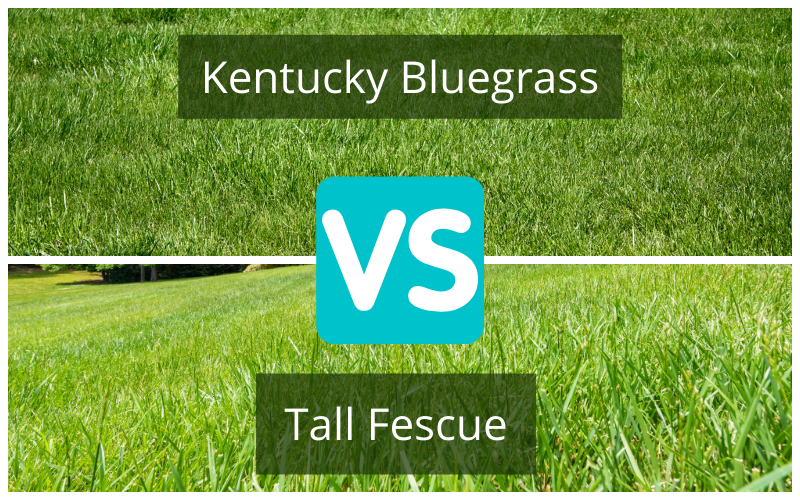If you’re wondering what turfgrass type you have or whether Kentucky bluegrass or tall fescue is better for a new lawn, this article should help you.
Not only will you learn what these two grass types have in common, but their biggest difference and ideal lawn conditions are also outlined.
Comparing Tall Fescue vs Kentucky Bluegrass
Tall fescue and Kentucky bluegrass are both excellent grass types when it comes to having an easy to maintain and highly adaptable lawn. However, both tall fescue and Kentucky bluegrass do have a few weaknesses and areas where one may outshine the other.
There is, however, no quick and thorough answer to, “What is the difference between Kentucky bluegrass and tall fescue?” but that answer does boil down to two basic factors: appearance and adaptability.
Appearance
This is the easy part of tall fescue vs Kentucky bluegrass identification. Both tall fescue and Kentucky bluegrass have dark green blades but while tall fescue has thin, coarse, broad blades, the blades of Kentucky bluegrass are thin and relatively fine.
Many people would describe the touch of a tall fescue lawn as “rough” or scratchy” while a Kentucky bluegrass lawn is undeniably soft. In fact, it’s one of the softest lawn grass types.
Best Uses for Tall Fescue and Kentucky Bluegrass
Tall fescue is the type of grass that gets planted in places where the turfgrass needs to hold up to a lot. This can mean it gets planted around animal pastures, around the stands in baseball fields, in parking lot medians, and along walking trails.
Not only does it hold up to traffic, but it also handles low nutrient levels, soil compaction, and high levels of contaminants better than many fine-bladed grass types.
Kentucky bluegrass is also a good choice for high-traffic areas but in a different way. Once established, Kentucky bluegrass produces a thick network of roots and rhizomes.
The way the sod is formed makes it difficult to disturb and excellent at repairing itself rapidly from compaction and traffic. Cutting and diffing, however, can cause problems.
This makes Kentucky bluegrass excellent for high-traffic lawns that need a soft feel or golf courses and athletic fields.
Soil Types and pH Needs of Tall Fescue and Kentucky Bluegrass
Tall fescue requires a pH of 5.5 to 7.5 to thrive. It works best when planted over rich, clay-based soils that retain moisture. They can even be highly compacted to the point where many plants and grass types would refuse to set roots.
Tall fescue spreads by sending tough stolons out into the surrounding soil, whether compacted or loose and creating new clumps of grass at the end of these stolons.
Kentucky bluegrass prefers well-drained or rich, damp soil. Once established it can even thrive in muddy conditions for long stretches as its root network and rhizomes will help keep the lawn in place.
The ideal pH for Kentucky bluegrass is 6 to 7 though it is more likely to do better in slightly alkaline soil than more acidic soil.
Water Needs for Tall Fescue and Kentucky Bluegrass
Tall fescue requires just 1” of water per week to thrive and, once established, can handle several weeks of drought without rusting or becoming dormant.
However, in hot and dry weather, tall fescue should be cut long, at least 3”, for best appearance.
Kentucky bluegrass needs a little more water to maintain its ideal texture and appearance with needs of about 1.25 to 1.5” of water per week.
Like tall fescue, Kentucky bluegrass can handle a little mud without much if any damage and neither variety is highly susceptible to mold or mildew.
Sun, Shade, and Temperature Requirements for Tall Fescue and Kentucky Bluegrass
Tall fescue does very well in mostly-shaded areas but thrives in part sun. In cooler zones, it can also do well in full sun.
High heat, however, can cause the ends of tall fescue to appear “burnt” or “rusted” if the proper moisture levels are not maintained and the grass is in direct sunlight.
The ideal growing temperature for tall fescue is about 65F and the grass is dormant below 50F and above 90F.
Kentucky bluegrass has similar temperature preferences, growing fastest between 60F and 70F. It will go dormant if temperatures are consistently below 50F or above 80F.
Kentucky bluegrass is, however, a fan of the sun and does its best in full sunlight, though it can handle intermittent or partial shade.
Durability of Tall Fescue or Kentucky Bluegrass Lawns
Tall fescue is one of the toughest grass varieties you could choose for a lawn.
Not only does it hold up to muddy conditions, damage from digging animals, compacted earth, and foot traffic, it also has excellent resistance to most insects, molds, mildews, and other common lawn diseases. It establishes itself at a quick pace and fills in bald patches quickly as well.
Kentucky bluegrass also does well in muddy conditions and with foot traffic. It can recover from digging animals and has similar resistance to insects and diseases.
However, it recovers from diffing and cutting more slowly than tall fescue and requires more moisture and nutrients to do so. It also has good resistance to contaminants, but nothing near what tall fescue can absorb.
Common Pests and Diseases for Tall Fescue Lawns and Kentucky Bluegrass Lawns
Neither tall fescue nor Kentucky bluegrass is more susceptible to any insects, animals, and diseases than the average turfgrass. Further, they have better than average recovery rates and resistance across the board.
Tall fescue, however, will recover more quickly and with fewer resources than Kentucky bluegrass.
Mowing Needs of Tall Fescue vs Kentucky Bluegrass Lawns
Tall fescue has an average growth speed and should be mown to a length of about 2” once a week during the cool seasons.
Once temperatures reach an average of 85F or above, mowing may not need to be done more than once or twice in a month if conditions are dry.
In hot weather, cutting the grass to a height of 3” reduces the likelihood of “burnt” ends.
Kentucky bluegrass can be mown as short as 1” and left as high as 3” with no ill effects. However, this is a fast-growing type of grass during the cool season, and the shorter it is, the more often it will need to be mown for an even appearance- as often as twice a week.
This also means that a Kentucky bluegrass lawn needs to be dethatched several times a year if cut shorter than 2”.
Types of Grass Related to Tall Fescue
The primary counterpart to tall fescue is fine fescue. This is a much broader category of fescue grasses, including both red fescue and creeping fescue.
The good news is that these fescues all have similar growth speeds, temperature needs, and nutrient requirements. They’re also all much softer than tall fescue.
The problem is that they can’t take nearly as much traffic or abuse as tall fescue.
Types of Grass Related to Kentucky Bluegrass
Have a problem with frequent droughts and water restrictions? Are grubs a major cause for concern in your area? Is the dormant temperature range for common Kentucky bluegrass causing you to second-guess your choices? There are specialized strains to help you out.
Kentucky bluegrass has over 200 specialized and patented strains to help create the best lawn you could ever hope to have. Some of them can even be combined to help combat multiple issues or reduce the damage from select pests.
The Best-Case-Scenario for a Tall Fescue or Kentucky Bluegrass Lawn
Kentucky bluegrass is an excellent grass type for a mostly sunny, well-drained to rainy spots with lots of expected traffic (either human or animal). However, it will need time to become established.
Once established, however, it should hold up very well over time and crowd out most turfgrass weeds- as long as the pH is maintained at an ideal level. Beyond that, Kentucky bluegrass requires little water, nutrients, or frequent mowing.
With all of that, you may be thinking, “Is Kentucky bluegrass better than tall fescue?” The answer? For home lawns, it often is. Unless you have clay soil, soil that compacts easily, or have trouble with moles and voles regularly.
Tall fescue may not be as pretty, but it’s tough and it will re-establish itself quickly if disturbed. Combine that with all of the adaptive elements Kentucky bluegrass has, too, and tall fescue may be the easiest turfgrass to maintain.
A Quick Comparison of Tall Fescue vs Kentucky Bluegrass
If you’re not quite sure of the differences between Tall Fescue and Kentucky Bluegrass, here’s a quick top-level overview for you to reference.
| Grass Type | Tall Fescue | Kentucky Bluegrass |
|---|---|---|
| Appearance | Dark Green with Coarse, Broad Blades | Dark Green with Plump, Fine Blades |
| Popular Uses | High Traffic Areas and Yards with Mostly Shade | Golf Courses and Athletic Fields, Roadsides |
| Ideal Soil Type and pH | Rich and Clay Soil is Ideal - 5.5 to 7.5 Ideal pH | Well-Drained to Moist – 6 to 7 Ideal pH |
| Water Requirements | 1” of Water Per Week – Average Overall Water Consumption | 1.25 to 1.5” of Water Per Week – Slightly Above Average Water Consumption |
| Sun/Shade/Temperature Needs | Shade Preferred/Dormant at 50F and Above 90F | Full Sun Preferred/Dormant Below 50F and Above 80F |
| Durability | High Durability, Fast Recovery | High Durability, Fast Recovery |
| Pests and Diseases | Fungus, Leaf Rust – Webworms, Thrips, Ants, Grubs | Geese, Digging Animals – Ants/Webworms/Thrips/Grubs – Spore-Based Diseases |
| Mowing Needs | Should Be Mown to 2” Height or 3”+ If Sunny and Hot – Grows Best in Cool Weather | Can Be Mown to 1” or Less – 2 to 3” Height Average – Grows Best in Cool Weather |



Overseeded w/ Turf type tall fescue. Mixes well w/ Kentucky blue. But cool soil beneath top is solid, non-draining clay. Grows poorly. Need drainage.
Hi Norman!
Thank you for this testimonial! It’s good to know when someone has success with a mix. For the clay soil, I would recommend adding humic acid or another liquid aeration product and scattering/mixing in some sand or organic compost over time. This should help with the drainage problem and support both grass types.
I hope this helps 🙂
Hi Norman!
Thank you for this testimonial! It’s good to know when someone has success with a mix. For the clay soil, I would recommend adding humic acid or another liquid aeration product and scattering/mixing in some sand or organic compost over time. This should help with the drainage problem and support both grass types.
I hope this helps 🙂